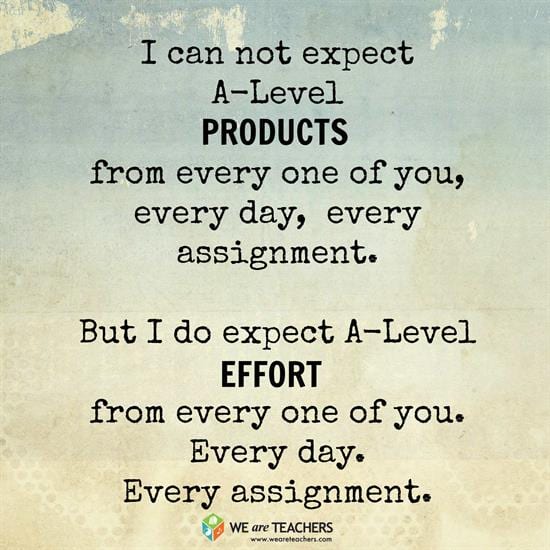How Academic Risk-Taking Dies in the Classroom
Picture a baby. A fresh one. Straight out of the womb. It's probably making a bunch of dissonance. It's probably gross looking (allow's be honest: this whole "cute newborn" thing is a myth). Despite the grossness of this baby, it came into the world wired with a sure skill fix.
On a résumé, this babe would probably list skills like:
– Defecation
– Crying
– Nonsensical racket making
– Breathing
– Sleeping
– Eating
That'due south substantially it. In other words, this child has cipher employable skills (Psssh … millennials these days …). But there's another major ability this child has in excess: risk-taking.
We are built-in gamble takers. Nosotros volition do simply about anything every bit babies, no affair what the event of the run a risk. Some of these risks are idiotic. Others are critical. Remember of ane of the nearly bones functions: walking.
Motion picture Babe A about to take his get-go steps. His parents are probably staring at him, rooting, clapping, grin, videotaping. Now, this movement will not bode well for Baby A, who volition most probable crash to the ground in an uncoordinated thump. But Baby A don't care. Baby A is a hazard taker. And as the much-anticipated fall happens, the parents no doubt scream and cheer rather than chastising their tot for failing.
What does Baby A practise after this failure? Endeavor again. And again. And again (at to the lowest degree until his parents can get that perfect Facebook-worthy video posted). Baby A volition do this until he can walk. And voilà! Nosotros have learning. Walking is not the most employable skill, but we have progress, people.
This natural chance-taking is critical to development. And yet, at a certain point, nosotros stop taking risks that help united states of america grow. Just we don't stop taking risks because of physical danger (I once saw a kid kicking himself in the forehead just to run across if he could, so I tin tell you physical danger is not an consequence for today's youth). We ultimately stop taking risks—positive risks that lead usa forrad—considering of social danger. And and so a critical question educators must ask themselves becomes: Are we creating a culture of academic chance-taking in our classrooms?
Accept the mutual adventure of answering a question in course. Imagine the growth potential if 100 per centum of our students attempted to answer 100 percent of the questions we asked 100 per centum of the time. Simply they don't—at least not at the secondary level. At that place'southward no physical danger in raising your manus in class, simply social danger.
Many early elementary classrooms are teeming with kids who yet ain that innate risk taking. When my wife asks her second graders a question, I see dozens of hands shoot upwards, vying for a chance to reply a question. Kids are elbowing one another for space. Grunting increases.
A loftier school teacher asks a question and it's a different story. Center contact drops, faces contort in a pseudo "wait-like-I'm-thinking" expression, and silence stalks the room. Maybe ane dauntless soul will flick a subtle wrist with a half-inch raise of the hand, hoping he or she isn't actually called on. We take witnessed a death in the blazon of take chances-taking we desire our immature learners to practise. But such academic risk-taking didn't die overnight.
Students lose this academic run a risk taking for many reasons. But ane of the primary reasons they lose information technology is considering we create a culture of social danger in our classrooms. Here's how:
1. We are more concerned with acknowledging the product than acknowledging the procedure.
With our hand-raising example information technology looks similar this:
Instructor asks young child a question: "What'south the solution to the equation six divided by two equals …?"
Immature kid feverishly elbows out competition, sure of success.
Teacher: "Aye, Taylor?"
Taylor: "12!"
Teacher: "Nope. Sorry, Taylor. Who has a better answer? Marcus?"
Marcus: "iii."
Instructor: "YES MARCUS! Neat job!" Maybe loftier-fives commence, anthems get-go playing, candy and Webkins get tossed to Marcus, celebrating his brilliance. Perhaps not. Regardless, the teacher has lavished praise on the product of learning (right answer) over the process of learning (attempt at solving). A message has been given, still subtle: Right answers get rewards. The subtext is: If you don't accept the right answer, don't try.
We know teachers don't intend to send this bulletin, just everything speaks. And putting product over process once doesn't kill academic risk-taking. But imagine if this message is given implicitly over and over.
Whose papers are hanging on the walls? The A papers. Not the papers that have shown the greatest growth from draft i to the final draft. Who gets the shout-outs in the newspapers and at ceremonies? The kids with the 4.0s. Not the kids who have worked their tails off to make up for those freshmen 1.0 mistakes.
Are products important? Yes. We still need to ensure that our students are competent and not just confident. Just we must consider how our over-focus on product often destroys the very process needed to develop the product itself.
Over the adjacent couple weeks, let's engage in a conversation well-nigh how to assist our learners—all learners, from kindergarten through their careers—revitalize that child-similar gamble-taking that created a blast of development.
Next week, nosotros'll share ideas on how to chop-chop, hands and consistently foster condom academic risks. Until then, post your thoughts: How do you foster a culture of academic chance-taking?

Chase Mielke is a learning junk ie who happens to have a love matter with teaching. A book addict by night and a teacher and instructional coach by day, he fantasizes almost former libraries and fresh Expo Markers. His obsessions with psychology, well-being and cognition often live on his blog, affectiveliving.wordpress.com.
faithfulyeatcheed.blogspot.com
Source: https://www.weareteachers.com/how-academic-risk-taking-dies-in-the-classroom/